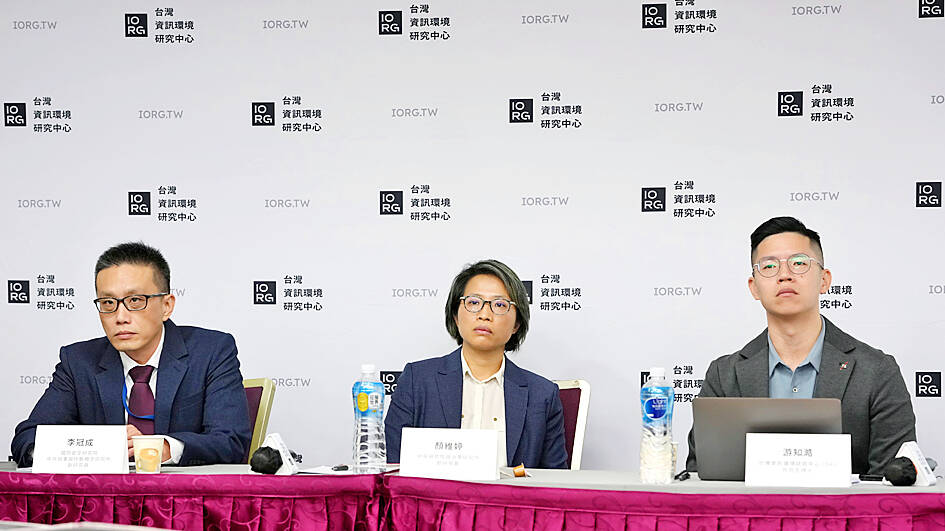Beijing is conducting a sophisticated campaign to demoralize Taiwanese by exploiting their economic anxieties and fear of war, a report released yesterday by a civil research organization showed.
China has been engaged in a systematic campaign to construct a narrative of “Taiwan defeatism” to encourage Taiwanese acquiescence, Information Operations Research Group codirector Yu Chih-hao (游知澔) told a news conference in Taipei.
The defeatist narrative is formed by framing news about Taiwan’s foreign affairs, national defense, economic issues and democracy with messaging that depicts the nation as weak and dependent on foreign powers, Yu said.

Photo: Chen Yi-kuan, Taipei Times
People who identify as both Taiwanese and Chinese have positive views of China’s economy and negative views of the Democratic Progressive Party government, and are more likely to accept defeatism, he said.
The types of issues Beijing seeks to leverage to spread defeatism reflect Taiwanese fears of being abandoned by allies, conflicted national identity and lack of education in national security matters, he said.
The defeatist worldview, built to dovetail with other Chinese information campaigns, creates a sense of crisis and then presents acquiescence to China as its solution, he said.
The promotion of defeatist messages is being timed to put a negative spin on specific events as they happen in real time, such as Taiwan’s annual Han Kuang military exercises, he said.
The vectors for Chinese propaganda include Taiwanese politicians and political pundits, social media accounts under the management of unknown organizations or individuals, Beijing’s leadership and state-run media, he said.
Chinese propaganda routinely quotes Taiwanese opposition figures, and makes use of idioms and phrases typically used in China to homogenize Taiwanese culture, language and public discourse, Yu said.
Citing a poll the center conducted last year, Yu said that 46 percent of Taiwanese are pessimistic about the nation’s economy and national security, suggesting a high level of potential susceptibility to Beijing’s propaganda.
TikTok users are more likely to approve of China and express pessimism about the economy, he said.
Chinese propaganda preys on anxiety and a sense of helplessness, especially in disinformation campaigns aimed at sowing division in Taiwan, he said.
The executive branch should enhance information governance, regulate the quality of open source media and emphasize critical reading skills in education, Yu said.
Academics should deepen interdisciplinary study of the information environment in Taiwan and promote public educational efforts, while Taiwanese should be more critical of the information they encounter online and base their discussion about public affairs on verifiable facts, he said.
The Information Operations Research Group seeks to spread public awareness about information manipulation.

‘WIN-WIN’: The Philippines, and central and eastern European countries are important potential drone cooperation partners, Minister of Foreign Affairs Lin Chia-lung said Minister of Foreign Affairs Lin Chia-lung (林佳龍) in an interview published yesterday confirmed that there are joint ventures between Taiwan and Poland in the drone industry. Lin made the remark in an exclusive interview with the Chinese-language Liberty Times (the Taipei Times’ sister paper). The government-backed Taiwan Excellence Drone International Business Opportunities Alliance and the Polish Chamber of Unmanned Systems on Wednesday last week signed a memorandum of understanding in Poland to develop a “non-China” supply chain for drones and work together on key technologies. Asked if Taiwan prioritized Poland among central and eastern European countries in drone collaboration, Lin

The US government has signed defense cooperation agreements with Japan and the Philippines to boost the deterrence capabilities of countries in the first island chain, a report by the National Security Bureau (NSB) showed. The main countries on the first island chain include the two nations and Taiwan. The bureau is to present the report at a meeting of the legislature’s Foreign Affairs and National Defense Committee tomorrow. The US military has deployed Typhon missile systems to Japan’s Yamaguchi Prefecture and Zambales province in the Philippines during their joint military exercises. It has also installed NMESIS anti-ship systems in Japan’s Okinawa

The Chien Feng IV (勁蜂, Mighty Hornet) loitering munition is on track to enter flight tests next month in connection with potential adoption by Taiwanese and US armed forces, a government source said yesterday. The kamikaze drone, which boasts a range of 1,000km, debuted at the Taipei Aerospace and Defense Technology Exhibition in September, the official said on condition of anonymity. The Chungshan Institute of Science and Technology and US-based Kratos Defense jointly developed the platform by leveraging the engine and airframe of the latter’s MQM-178 Firejet target drone, they said. The uncrewed aerial vehicle is designed to utilize an artificial intelligence computer

Renewed border fighting between Thailand and Cambodia showed no signs of abating yesterday, leaving hundreds of thousands of displaced people in both countries living in strained conditions as more flooded into temporary shelters. Reporters on the Thai side of the border heard sounds of outgoing, indirect fire yesterday. About 400,000 people have been evacuated from affected areas in Thailand and about 700 schools closed while fighting was ongoing in four border provinces, said Thai Rear Admiral Surasant Kongsiri, a spokesman for the military. Cambodia evacuated more than 127,000 villagers and closed hundreds of schools, the Thai Ministry of Defense said. Thailand’s military announced that